
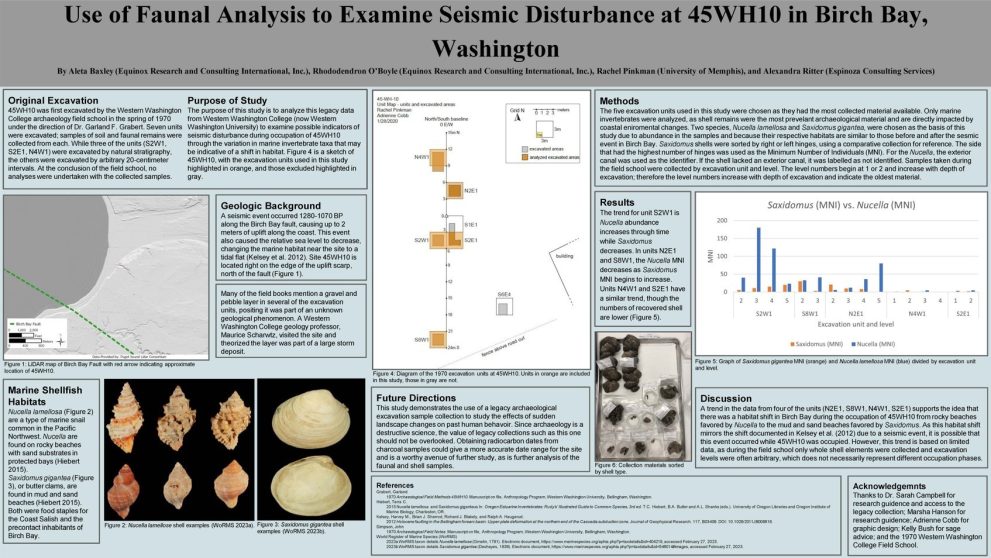 The purpose of this study is to analyze this legacy data
The purpose of this study is to analyze this legacy data
from Western Washington College (now Western
Washington University) to examine possible indicators of
seismic disturbance during occupation of 45WH10
through the variation in marine invertebrate taxa that may
be indicative of a shift in habitat.
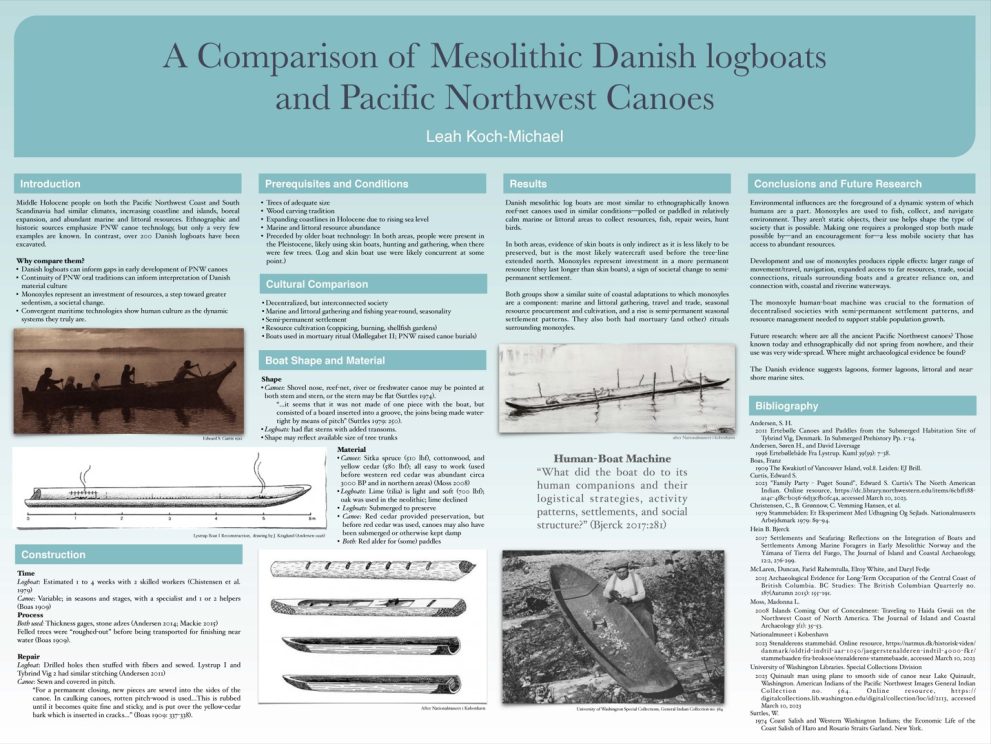 Background: Pacific Northwest ethnographic information about canoe usage and building techniques can be compared to the many Danish mesolithic logboats currently in the archaeological record. Both maritime cultures created watercraft from single tree trunks. There are no surviving precontact Pacific Northwest canoes, and many Danish mesolithic logboats. Conversely, there is no ethnographic information for Danish mesolithic maritime cultures, whereas the Pacific Northwest has post-contact ethnographies and historical sources showing a dynamic but continuous use of single-trunk boat technology.
Background: Pacific Northwest ethnographic information about canoe usage and building techniques can be compared to the many Danish mesolithic logboats currently in the archaeological record. Both maritime cultures created watercraft from single tree trunks. There are no surviving precontact Pacific Northwest canoes, and many Danish mesolithic logboats. Conversely, there is no ethnographic information for Danish mesolithic maritime cultures, whereas the Pacific Northwest has post-contact ethnographies and historical sources showing a dynamic but continuous use of single-trunk boat technology.
Method: A comparison of single-trunk watercraft technology, environmental similarities, and prehistoric population patterns in similar maritime cultures. Watercraft technology ties together environment and social organisation in a way few other artifacts do, becoming Hein Bjerck’s human-boat-machine.
Results: Single-trunk watercraft technology was developed in the face of similar environmental pressures and resources, and the comparison illuminates technological convergence between temporally and geographically distant cultures.
Conclusion: An adaptation to and reliance on single-trunk maritime watercraft contributed to the formation of decentralised societies with semi-permanent settlement patterns, and resource management, allowing stable population growth.
Redeposited cultural resources were found in the tidal zone of natural backshore deposits associated with the now-reclaimed barrier beach and lagoon at Windjammer Park, in Oak Harbor, Washington. The cultural resources were found landward of intact and disturbed deposits of National Register-eligible precontact archaeological site 45IS298. While monitoring machine excavations well away from the present seashore between 1.5 m above mean sea level and 1.25 m below, we observed isolated, sensitive cultural resources, including basketry fragments, in thickly bedded, very dark gray, poorly to very poorly sorted deposits with particle sizes ranging from sand- to very coarse pebbles, whole and fragmentary marine shell, and larger particles of organic material, such as driftwood. While it seemed obvious that these were not cultural deposits, per se, it was not immediately clear how these cultural materials could have been naturally displaced from the midden, which is at least 100 m closer to the present shoreline. We conclude that these deposits are the result of ‘overwash’ events that are known to occur on barrier beaches during times of extremely high tides. At such times, storm-driven, high-energy wind waves burst over and through the beach ridge, entraining everything in their paths, and creating a moving mass of material analogous to a debris flow. As the flow loses energy it forms a ‘washover sheet’ on the back shore; if it passes into the lagoon, it forms a ‘washover delta.’
This paper explores the effect of feminist thought on the rise of CRM in the 1980’s and gives some specific anecdotal herstorical contingencies for how we do what we do today. Incredible characters in the story of Feminist Archaeology in the northwest are highlighted. A critique is provided of how modern sexist thought has infected our analysis and interpretation of the archaeological record. Also included is a brief feminist evaluation of the modern
state of CRM.
This talk is for people working in Cultural Resource Management who want to go from good to great, who want to be part of a science- and ethics-based business, who want to wake up every morning excited about what they do. Do you spend even part of your time justifying your work to hostile or ambivalent clients or land owners and wish you could say more than “because you are required to?” If you want to make sure that cultural deposits, features, objects and buildings have a chance to get older because you and your clients protected them, then step right up. Consider the thousand small moments that through insight and hard work you line up in the right direction to inspire people to protect something that they might not have known existed. Help your clients to get excited about your work and be happy when they write that check. This paper is about finding ways to get agencies, clients, taxpayers—anyone—excited about heritage preservation, and for everyone who wants to take action every day to make this industry better.
Come hear about the tactics for risk reduction that we have been implementing on projects, large and small, in Northern Puget Sound—ideas developed in planning and used in the field, how they worked, what we would change, and how to identify opportunities and synergies. We work with a wide range of stakeholders and listen to tribes and agencies to understand what are their critical issues. In particular, project engineers and project managers know their projects better than anyone; we have had real success asking for what we need and then listening to the great ideas they come up with, and most importantly working with them on implementation to avoid, minimize or mitigate the impact to cultural resources. This talk will provide concrete examples of what we have tried and why. We can show you how vetting great plans and getting everyone in the room saves money and resources. There is no reason not to do it, and frankly if we want to stay relevant and funded we had better work harder at becoming great, flexible, cutting-edge risk-takers and risk managers.
Site 45SJ50 is a culture rich shell midden located on a headland at the north end of Roche Harbor on San Juan Island, Washington. Historically the landform was used as the site of the Roche Harbor Lime Company Staveless Barrel Factory, and more recently it has been the location of a private residence. Field research beginning in the spring of 2015 allowed for the collection of midden samples that were radiocarbon dated to between 3459 ± 30 B.P. and 2595 ± 30 B.P. With dates that place this site in the Locarno Beach phase, it was quite interesting to find what appears to be a modified fragment of glass, which had subsequently been rolled in the beach splash zone among many other pieces of possible historic glass. Such an artifact provides a unique perspective into the possible protohistoric occupation of the area.
Human modification to the landscape has been occurring throughout human occupation, and continues into the historic period, where the scope and magnitude of this modification has intensified. This poster explores through specific examples the importance of identifying historic modifications to the landscape before engaging in fieldwork, and the ways in which this knowledge can inform and alter the interpretation of both historic and precontact deposits. Examples for this poster are taken directly from data gathered during mitigative CRM projects on Whidbey Island in Washington State, and explore the impact of factors such as the development of public infrastructure, wetland reclamation, and recreation on the precontact and historic record.
Public outreach and education are critical to the work of archaeologists. Through outreach we can inspire our clients to act as good stewards for cultural resources, find new support for the protection of archaeological sites, unify communities, empower people, explore identity and perspective, expose people to new worldviews and much more. Archaeological outreach includes providing guidance to our local government clients on how they can best keep the people they serve informed. Over the past four years, Equinox Research and Consulting (ERCI) has worked extensively for and with the City of Oak Harbor in Washington. ERCI has had the opportunity to try out a variety of public education tactics and has worked with the City as they have provided archaeological outreach. Using the tried successes and failures in Oak Harbor, this talk will discuss how to design an archaeological public outreach program with a local government.
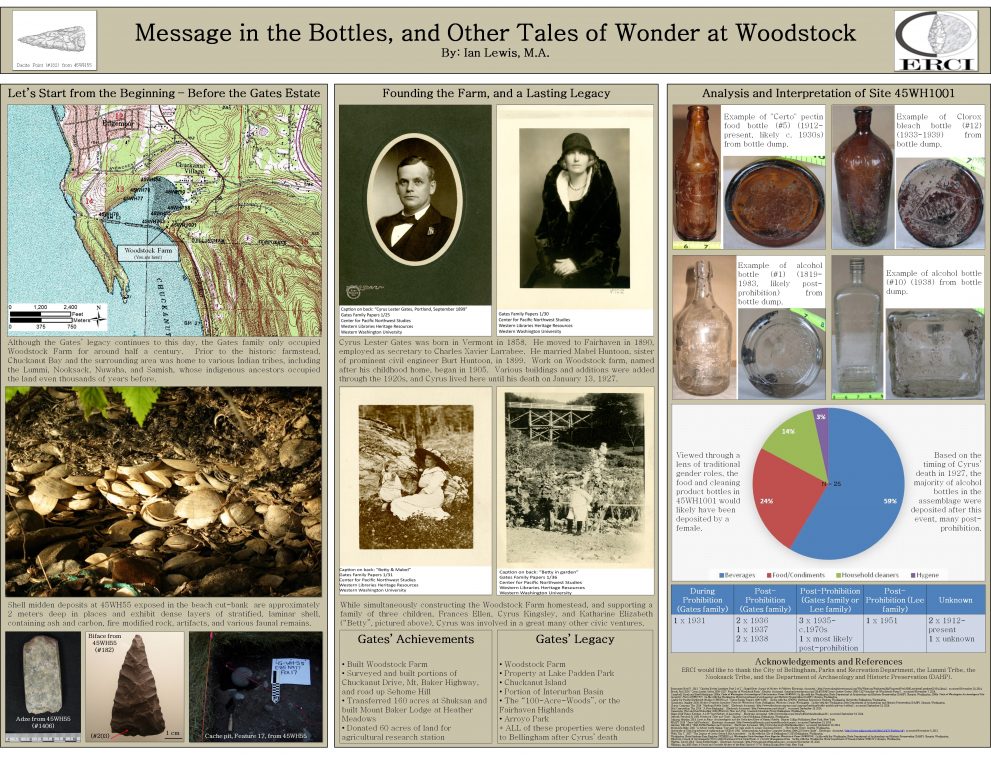 To most people, a bunch of bottles in the dirt is simply that, a bunch of bottles. Trash. Perhaps recycling. But mainly useless trash. Even as archaeologist, we recognize such objects as trash, yet the difference is we do not see this trash as useless. Site 45WH1001, a historic bottle dump dating to the early 1900s, was inadvertently discovered winter 2014 by sewer utility trenching within the Woodstock Farm Campus in Whatcom County, Washington. Much historic and archival information is available regarding the occupants of Woodstock Farm, but the message contained in these bottles provides even more insight into one of the most fascinating and influential founding families of Whatcom County.
To most people, a bunch of bottles in the dirt is simply that, a bunch of bottles. Trash. Perhaps recycling. But mainly useless trash. Even as archaeologist, we recognize such objects as trash, yet the difference is we do not see this trash as useless. Site 45WH1001, a historic bottle dump dating to the early 1900s, was inadvertently discovered winter 2014 by sewer utility trenching within the Woodstock Farm Campus in Whatcom County, Washington. Much historic and archival information is available regarding the occupants of Woodstock Farm, but the message contained in these bottles provides even more insight into one of the most fascinating and influential founding families of Whatcom County.
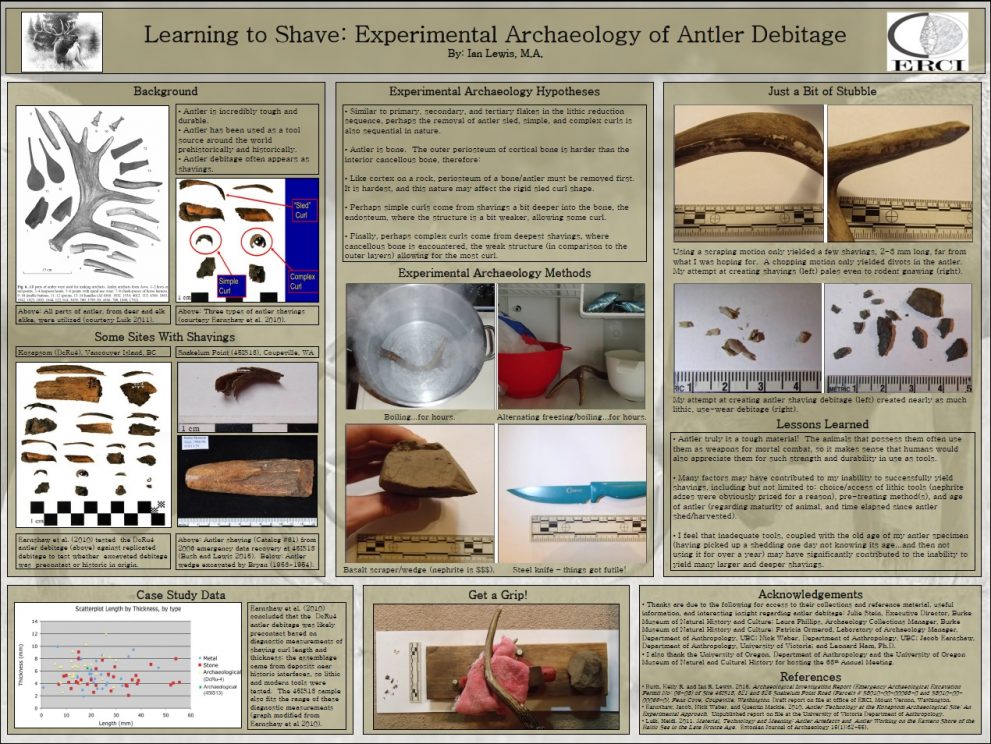 Antler, due to its dense nature was used for a variety of tools, ranging from points and pressure flakers to wedges and handles. Many archaeologist recognize the characteristic marks left on antler as a result of adzing to reduce antler beams into manageable pieces and blanks. Similar to bone, antler can sometimes even be flaked and fractured, though not as easily as stone. However, not much notice has been given to antler shavings in the archaeological record. There are three types of antler shavings, or curls. The goal of this experimental archaeology was to test whether or not the three types of antler shavings are produced sequentially, possibly similar to the primary, secondary and tertiary flakes of the lithic reduction sequence.
Antler, due to its dense nature was used for a variety of tools, ranging from points and pressure flakers to wedges and handles. Many archaeologist recognize the characteristic marks left on antler as a result of adzing to reduce antler beams into manageable pieces and blanks. Similar to bone, antler can sometimes even be flaked and fractured, though not as easily as stone. However, not much notice has been given to antler shavings in the archaeological record. There are three types of antler shavings, or curls. The goal of this experimental archaeology was to test whether or not the three types of antler shavings are produced sequentially, possibly similar to the primary, secondary and tertiary flakes of the lithic reduction sequence.
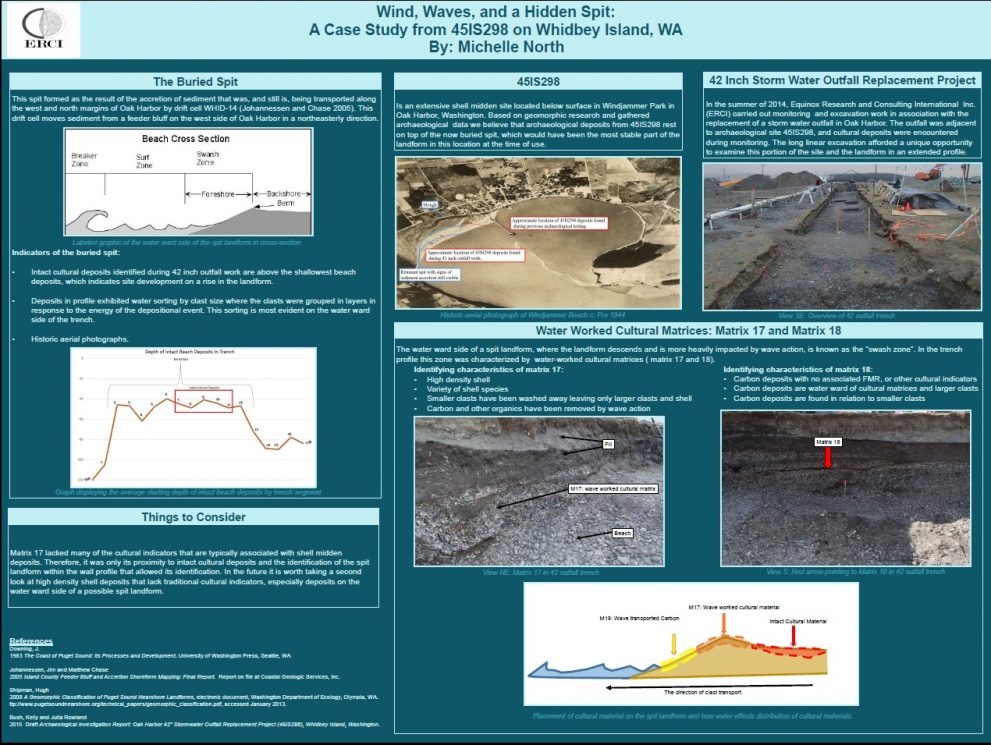 Shell midden sites rich in cultural importance and material found along shorelines are effected by coastal processes that exist in conjunction with the landforms they are built upon. The presentation is a case study of a shell midden matrix identified during salvage work during the City of Oak Harbor 42 Inch Storm Water Outfall Project on Whidbey Island in Oak Harbor, WA. The matrix had been heavily effected by erosional processes and storm events prior to becoming covered with modern fill, which effectively hid this portion of the site and the land form it exists on, until its excavation in 2014.
Shell midden sites rich in cultural importance and material found along shorelines are effected by coastal processes that exist in conjunction with the landforms they are built upon. The presentation is a case study of a shell midden matrix identified during salvage work during the City of Oak Harbor 42 Inch Storm Water Outfall Project on Whidbey Island in Oak Harbor, WA. The matrix had been heavily effected by erosional processes and storm events prior to becoming covered with modern fill, which effectively hid this portion of the site and the land form it exists on, until its excavation in 2014.